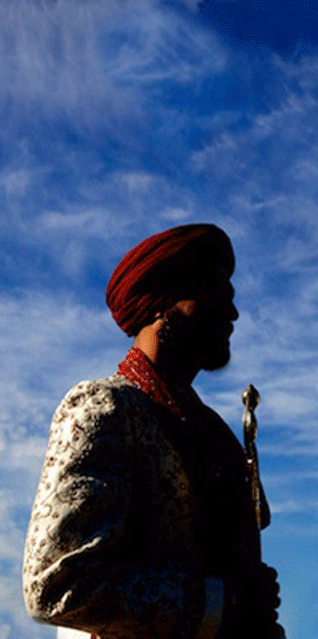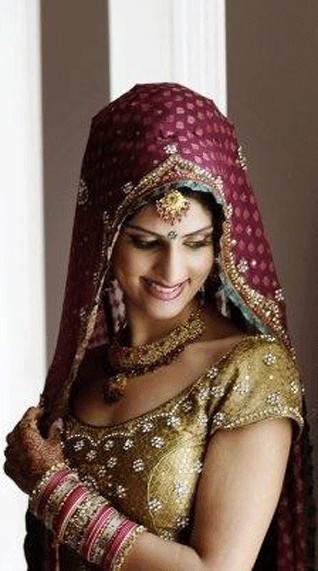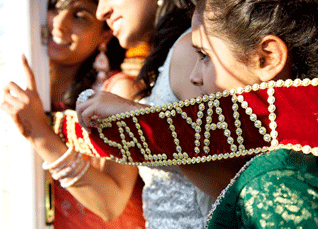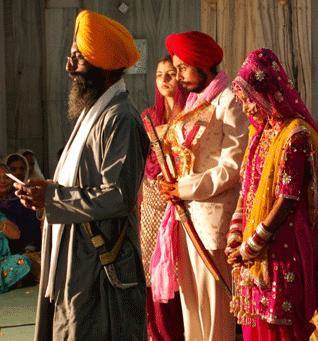Resource Library
Marriage in Sikhism: Part II - Anand Kaaraj
by MANJIT SINGH
The following is a continuation of the two-part article, Marriage in Sikhism. Part I ("Background") was posted yesterday.
PART II - ANAND KAARAJ
Sikh marriage is monogamous.
Marriage is a sacrament, a sacred bond for attaining spiritual and worldly joy.
The Sikh marriage ceremony is called Anand Kaaraj - literally, 'The
Ceremony of Bliss' - because it is a ceremony where two souls meet and strive for perfect harmony in leading their lives together.
Although there is no provision for divorce in Sikhism, divorces do occur among Sikhs. Parties asking for divorce must follow the civil law of the land and proceed accordingly. There is no provision for divorce through any religious channel. There is no restriction on remarriage by a divorced individual. Similarly, widows and widowers are allowed to marry again. Individuals affected under any one of the above conditions are eligible to solemnize their second marriage through a religious ceremony.
Sikhism does not condone pre- or extra-marital sex. Sikhism recognizes that sexual drive is innate to human nature, it does not subscribe to the idea of free-for-all sex however. Laxity in sexual behavior is considered a lustful action. This is why the institution of marriage and family are the recommended paths to manage the sexual drive.
Lust is one of the five vices that a Sikh must learn to desist from. The other four vices are greed, anger, materialism and pride.
In the Sikh religion, there are no ordained priests. Any Sikh adult, male or female, can perform any ceremony including a marriage in the presence of the scripture, the Guru Granth Sahib.
All Sikh ceremonies are simple. The essential part of any ceremony is prayer.
Anand Kaaraj or the marriage ceremony is also very simple.
It begins with a prayer, after which Laavaa(n) or the marriage vows, are first read from the Guru Granth and then sung by the musicians. Finally, the ceremony is ended with a congregational prayer.
To solemnize a marriage, Sikhs invoke the presence of the Creator by congregating in the presence of the Guru Granth. Sikhs believe that God resides in the congregation.
According to Sikh belief, the aim of married life is total union between two souls so that they can jointly strive to get closer to the Creator who is the giver of every thing that we have on this earth. The four marriage hymns or Laavaa(n) that are recited and then sung contain deep spiritual and ethical messages for the couple for getting closer to the Creator. There are four steps for this journey which leads to a life of bliss.
These are: respect, love, restraint and harmony.
The bride and the groom are asked in these hymns to cultivate these four qualities so that the couple can develop a strong spiritual bond between themselves, which is a template for getting closer to the Creator.
As part of the ceremony, the bride and the groom walk around the Scripture four times.
They should do so with a feeling and faith that they are beginning the journey of a joint life to make themselves inseparably one, to make their united life a shining example of spiritual excellence. For Sikhs, the family way of life is the most superior and natural way of life. Sikh conjugal relations are designed not merely to promote creature comforts or to perpetuate the human race, but to provide the best means of approaching God and cultivating our married lives in such a manner as to make it a physical, intellectual and spiritual union.
It says in the Guru Granth that "they are not to be called husband and wife who merely live together; rather, they are husband and wife who have one spirit in two bodies."
The foregoing highlighted the spiritual side of the Sikh marriage. In addition to this, there is a temporal commitment which must be made by the bride and the groom.
Before the Anand Karaj ceremony can begin, the bride and the groom must acknowledge that they are in agreement with two things that will have a fundamental bearing on the structure and quality of their relationship as husband and wife.
The first deals with the mutual position of the two parties in the marriage. As per Sikh teachings, the husband and wife have an equal status. They are two wheels of the chariot of life. This is to say that every thing must be in balance if they are to enjoy a life full of bliss. As stated earlier, family life is the highest and most sacred order in Sikhism. The fidelity of a wife to her husband is as essential as the fidelity of a husband to his wife.
The second commitment deals with doing their best in terms of practicing mutual respect, love, restraint and harmony. As two people who are about to embark together on the journey of life through marriage, the bride and groom are to be content with each other, to respect each other, to care for each other and to make every effort humanly possible to lead life as moral and decent human beings. The bride and the groom give their commitment to the above by bowing their heads to the Guru Granth.
At this point, the bride and the groom and their respective parents or designated relatives acting in lieu of parents stand up in the congregation and a short prayer is said to seek the blessings of the Creator.
After this, the marriage ceremony commences.
Same Sex Relations
Consistent with the cultural norms of the subcontinent, the issue of same sex relations has never been considered a mainstream societal concern. All religious traditions on the subcontinent have historically ignored same sex issues in as much as individuals in same sex relations have never gone public with their life style option.
As things stand currently, it is safe to state that no gurdwara, the Sikh house of worship, would provide religious service for marrying a same sex couple even though there are no legal impediments in, for example, Canada, for such a union.
There is no reference in the Sikh scripture about same sex relations. Over eighty percent of Sikh adults are first generation immigrants in Canada. Their cultural values reflect their roots. There is no guarantee, however, that the Canadian-born Sikh generation, upon reaching adulthood, will stay committed to the norms of their parents. It is quite conceivable that the next generation could end up throwing open the doors of the gurdwaras to same sex marriages.
Conclusion
The traditional marriage institution in Sikhism is very solid.
Forecasting the future is a risky business. Based on current trends, however, there is nothing on the horizon that would indicate that time-tested Sikh values concerning marriage are about to change.
[S. Manjit Singh teaches Sikhism in the Faculty of Religious Studies at McGill University, Montreal, Quebec, Canada. He is Director of McGill's Chaplaincy Services. Presently, he is the President of the Interfaith Council of Montreal.]
August 22, 2010
Conversation about this article
1: Baljit Singh (Los Angeles, California, United States), August 25, 2010, 1:36 AM.
I beg to differ with your view on same-sex marriage. Sikh marriage categorically is between a man and a woman. While there is an attempt to redefine marriage to include same-sex marriage, we must guard against this anomaly that could upset the family structure.
2: Amarjit Singh (Ghaziabad, India), September 03, 2010, 10:12 AM.
Sikhism strictly prohibits from having pre- or extra-marital sex. And as per the hukam of Guru Gobind Singh Ji, Sikh parents are not supposed to give their daughter's hand to any clean shaven person/ non-Sikh. Sikh parents must give their daughters to such a family where Akal Purakh's Sikhi resides. This is what our tenth Master ordered his Sikhs to follow in his 52 Hukams or sermons which every Sikh ought to follow. But on the contrary, we hear a number of cases in India and abroad where Sikh females choose to marry non-Sikhs or clean shaven Sikhs. Unfortunately, we don't even bother to read what the 52 Hukams are as per given by Guru Sahib.
3: P. Singh (Winnipeg, Manotoba, Canada), April 23, 2012, 8:56 AM.
How do you feel about intermarriages who marry both in the Christian church and the Guru Granth Sahib, because the bride and groom come from different faith background?






